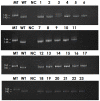Development of E-ice-COLD-PCR assay combined with HRM analysis for Nucleophosmin1 gene mutation detection in acute myelogenous leukemia
- PMID: 36103476
- PMCID: PMC9473412
- DOI: 10.1371/journal.pone.0274034
Development of E-ice-COLD-PCR assay combined with HRM analysis for Nucleophosmin1 gene mutation detection in acute myelogenous leukemia
Abstract
Mutations of the nucleophosmin1 (NPM1) gene represent the most frequent molecular alteration in acute myelogenous leukemia (AML), especially in patients with AML who have a normal karyotype. These alterations have been shown to carry favorable prognostic significance in patients with AML. Several methods have been developed for detection of NPM1 gene mutations. However, their ability to detect low levels of mutations in a wild-type background is limited. In this study, the Enhance improved and complete enrichment Co-amplification at Lower Denaturation temperature Polymerase Chain Reaction (E-ice-COLD-PCR) assay combined with High Resolution Melting (HRM) analysis was developed and validated for highly specific and sensitive screening for NPM1 gene mutations. A total of 83 blood samples from patients with AML were collected, and their DNA was extracted. For mutational analysis, the E-ice-COLD-PCR assay for the detection of NPM1 gene mutations was developed. PCR products were analyzed by HRM analysis. All positive samples were confirmed by direct sequencing. This assay enabled detection specificity and sensitivity of NPM1 mutations in 9/83 patients with AML. Direct sequencing results were 100% concordant with this method. In addition, the limit of detection was 12.5% mutant in the final concentration of 5 ng genomic DNA. The E-ice-COLD-PCR assay with HRM analysis is a highly specific and sensitive screening method for enrichment of detecting NPM1 gene mutations. This method has both a short turn around time and easier interpretation compared to those of other methods.
Conflict of interest statement
The authors have declared that no competing interests exist.
Figures






Similar articles
-
An allele-specific rt-PCR assay to detect type A mutation of the nucleophosmin-1 gene in acute myeloid leukemia.J Mol Diagn. 2008 May;10(3):212-6. doi: 10.2353/jmoldx.2008.070166. Epub 2008 Apr 10. J Mol Diagn. 2008. PMID: 18403613 Free PMC article.
-
NPM1 Mutation Analysis in Acute Myeloid Leukemia: Comparison of Three Techniques - Sanger Sequencing, Pyrosequencing, and Real-Time Polymerase Chain Reaction.Turk J Haematol. 2018 Mar 1;35(1):49-53. doi: 10.4274/tjh.2017.0095. Epub 2017 Nov 13. Turk J Haematol. 2018. PMID: 29129825 Free PMC article.
-
[Evaluation of methods for detection of NPM1 gene mutations in acute myeloid leukemia].Zhongguo Shi Yan Xue Ye Xue Za Zhi. 2011 Aug;19(4):999-1004. Zhongguo Shi Yan Xue Ye Xue Za Zhi. 2011. PMID: 21867632 Chinese.
-
[Research on NPM1 gene mutations in acute myeloid leukemia].Zhongguo Shi Yan Xue Ye Xue Za Zhi. 2013 Feb;21(1):258-62. doi: 10.7534/j.issn.1009-2137.2013.01.053. Zhongguo Shi Yan Xue Ye Xue Za Zhi. 2013. PMID: 23484732 Review. Chinese.
-
Nucleophosmin gene mutations in acute myeloid leukemia.Arch Pathol Lab Med. 2006 Nov;130(11):1687-92. doi: 10.5858/2006-130-1687-NGMIAM. Arch Pathol Lab Med. 2006. PMID: 17076533 Review.
Cited by
-
Current and Emerging Techniques for Diagnosis and MRD Detection in AML: A Comprehensive Narrative Review.Cancers (Basel). 2023 Feb 21;15(5):1362. doi: 10.3390/cancers15051362. Cancers (Basel). 2023. PMID: 36900154 Free PMC article. Review.
References
-
- Rojanamatin J, Ukranun Q, Supattagorn P, Chaiviriyabunya I, Wongsena M, Chaiweerawattana A, et al.. Cancer in Thailand. Bangkok: Medical Record and Databased Cancer Unit; 2021. [cited 2022 Jul 25] https://www.nci.go.th/e_book/cit_x/index.html
-
- Mevatee P, Tantiworawit A, Traisathit P, Puaninta C, Mevatee U, Angsuchawan S, et al.. FLT3-ITD, NPM1, and DNMT3A Gene Mutations and Risk Factors in Normal Karyotype Acute Myeloid Leukemia and Myelodysplastic Syndrome Patients in Upper Northern Thailand. Asian Pac J Cancer Prev. 2017;18(11):3031–9. doi: 10.22034/APJCP.2017.18.11.3031 - DOI - PMC - PubMed
MeSH terms
Substances
LinkOut - more resources
Full Text Sources
Medical

